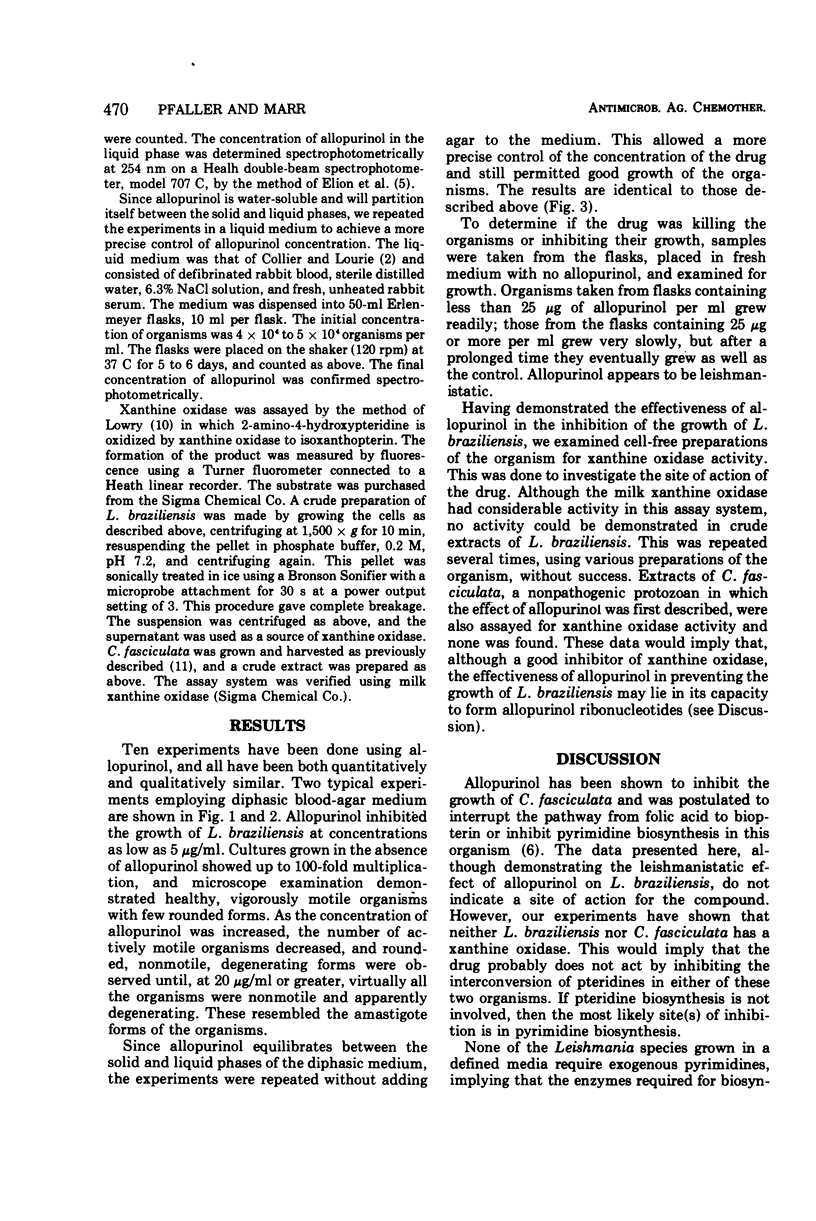Abstract
Allopurinol (4-hydroxypyrazolo[3,4-d]pyrimidine) has been shown to inhibit the growth of Leishmania braziliensis in vitro at concentrations which are attainable in human tissues and body fluids. This compound is believed to act by interdicting the de novo synthesis of pyrimidines, probably through the formation of allopurinol ribotide. Its lack of toxicity makes it a potential candidate for animal experimentation and it may serve as a prototype for other agents with similar mechanisms of action.
Full text
PDF



Selected References
These references are in PubMed. This may not be the complete list of references from this article.
- Beardmore T. D., Kelley W. N. Mechanism of allopurinol-mediated inhibition of pyrimidine biosynthesis. J Lab Clin Med. 1971 Nov;78(5):696–704. [PubMed] [Google Scholar]
- CROWTHER S., FULTON J. D., JOYNER L. P. The metabolism of Leishmania donovani in culture. Biochem J. 1954 Feb;56(2):182–185. doi: 10.1042/bj0560182. [DOI] [PMC free article] [PubMed] [Google Scholar]
- Dewey V. C., Kidder G. W. Effects of long-chain mono- and dicarboxylic acids on the pteridine requirement of Crithidia. Arch Biochem Biophys. 1966 Aug;115(2):401–406. doi: 10.1016/0003-9861(66)90289-x. [DOI] [PubMed] [Google Scholar]
- Dewey V. C., Kidder G. W. The sites of action of allopurinol in Crithidia fasciculata. J Protozool. 1973 Nov;20(5):678–682. doi: 10.1111/j.1550-7408.1973.tb03597.x. [DOI] [PubMed] [Google Scholar]
- Elion G. B., Kovensky A., Hitchings G. H. Metabolic studies of allopurinol, an inhibitor of xanthine oxidase. Biochem Pharmacol. 1966 Jul;15(7):863–880. doi: 10.1016/0006-2952(66)90163-8. [DOI] [PubMed] [Google Scholar]
- Frank O., Baker H., Hutner S. H. Antagonists of growth inhibition of Crithidia by allopurinol, a guanine analog. J Protozool. 1970 May;17(2):153–158. doi: 10.1111/j.1550-7408.1970.tb02346.x. [DOI] [PubMed] [Google Scholar]
- Janovy J., Jr Respiratory changes accompanying Leishmania to leptomonad transformation in Leishmania donovani. Exp Parasitol. 1967 Feb;20(1):51–55. doi: 10.1016/0014-4894(67)90021-5. [DOI] [PubMed] [Google Scholar]
- Kelley W. N., Fox I. H., Beardmore T. D., Meade J. C. Allopurinol and oxipurinol: alteration of purine and pyrimidine metabolism in cell culture. Ann N Y Acad Sci. 1971 Jul 6;179:588–595. doi: 10.1111/j.1749-6632.1971.tb46935.x. [DOI] [PubMed] [Google Scholar]
- Marr J. J. Crithidia fasciculata: regulation of aerobic fermentation by malic enzyme. Exp Parasitol. 1973 Jun;33(3):447–457. doi: 10.1016/0014-4894(73)90112-4. [DOI] [PubMed] [Google Scholar]
- Rembold H., Gutensohn W. 6-Hydroxylation of the pteridine ring by xanthine oxidase. Biochem Biophys Res Commun. 1968 Jun 10;31(5):837–841. doi: 10.1016/0006-291x(68)90639-6. [DOI] [PubMed] [Google Scholar]
- Rundles R. W., Wyngaarden J. B. Drugs and uric acid. Annu Rev Pharmacol. 1969;9:345–362. doi: 10.1146/annurev.pa.09.040169.002021. [DOI] [PubMed] [Google Scholar]
- Simpson L. The leishmania-leptomonad transformation of Leishmania donovani: nutritional requirements, respiration changes and antigenic changes. J Protozool. 1968 Feb;15(1):201–207. doi: 10.1111/j.1550-7408.1968.tb02112.x. [DOI] [PubMed] [Google Scholar]
- Trager W. Pteridine requirement of the hemoflagellate Leishmania tarentolae. J Protozool. 1969 May;16(2):372–375. doi: 10.1111/j.1550-7408.1969.tb02284.x. [DOI] [PubMed] [Google Scholar]
- Ziegler I. Pterine als Wirkstoffe und Pigmente. Ergeb Physiol. 1965;56:1–66. [PubMed] [Google Scholar]


